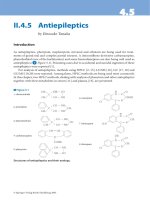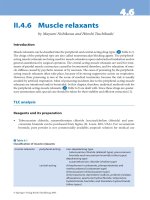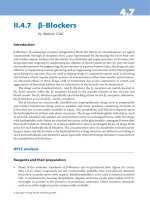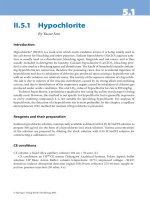Handbook of EEG interpretation - part 1 ppt
Bạn đang xem bản rút gọn của tài liệu. Xem và tải ngay bản đầy đủ của tài liệu tại đây (725.16 KB, 29 trang )
Handbook of
EEG
INTERPRETATION
This page intentionally left blank
Handbook of
EEG
INTERPRETATION
William O. Tatum, IV, DO
Section Chief, Department of Neurology, Tampa General Hospital
Clinical Professor, Department of Neurology, University of South Florida
Tampa, Florida
Aatif M. Husain, MD
Associate Professor, Department of Medicine (Neurology), Duke University Medical Center
Director, Neurodiagnostic Center, Veterans Affairs Medical Center
Durham, North Carolina
Selim R. Benbadis, MD
Director, Comprehensive Epilepsy Program, Tampa General Hospital
Professor, Departments of Neurology and Neurosurgery, University of South Florida
Tampa, Florida
Peter W. Kaplan, MB, FRCP
Director, Epilepsy and EEG, Johns Hopkins Bayview Medical Center
Professor, Department of Neurology, Johns Hopkins University School of Medicine
Baltimore, Maryland
Acquisitions Editor: R. Craig Percy
Developmental Editor: Richard Johnson
Cover Designer: Steve Pisano
Indexer: Joann Woy
Compositor: Patricia Wallenburg
Printer: Victor Graphics
Visit our website at www.demosmedpub.com
© 2008 Demos Medical Publishing, LLC. All rights reserved. This book is pro-
tected by copyright. No part of it may be reproduced, stored in a retrieval sys-
tem, or transmitted in any form or by any means, electronic, mechanical,
photocopying, recording, or otherwise, without the prior written permission of
the publisher.
Library of Congress Cataloging-in-Publication Data
Handbook of EEG interpretation / William O. Tatum IV [et al.].
p. ; cm.
Includes bibliographical references and index.
ISBN-13: 978-1-933864-11-2 (pbk. : alk. paper)
ISBN-10: 1-933864-11-7 (pbk. : alk. paper)
1. Electroencephalography—Handbooks, manuals, etc. I. Tatum, William O.
[DNLM: 1. Electroencephalography—methods—Handbooks. WL 39 H23657 2007]
RC386.6.E43H36 2007
616.8'047547—dc22
2007022376
Medicine is an ever-changing science undergoing continual development. Research and
clinical experience are continually expanding our knowledge, in particular our knowledge
of proper treatment and drug therapy. The authors, editors, and publisher have made
every effort to ensure that all information in this book is in accordance with the state of
knowledge at the time of production of the book.
Nevertheless, this does not imply or express any guarantee or responsibility on the part of
the authors, editors, or publisher with respect to any dosage instructions and forms of
application stated in the book. Every reader should examine carefully the package inserts
accompanying each drug and check with a his physician or specialist whether the dosage
schedules mentioned therein or the contraindications stated by the manufacturer differ
from the statements made in this book. Such examination is particularly important with
drugs that are either rarely used or have been newly released on the market. Every dosage
schedule or every form of application used is entirely at the reader’s own risk and respon-
sibility. The editors and publisher welcome any reader to report to the publisher any dis-
crepancies or inaccuracies noticed.
Made in the United States of America
07 08 09 10 5 4 3 21
This book is dedicated to our families,
our fine colleagues interested in EEG,
our friends in the field of EEG technology,
and especially our patients.
This page intentionally left blank
vii
CONTENTS
Preface ix
1 Normal EEG 1
William O. Tatum, IV
2 Abnormal Nonepileptiform EEG 51
Selim R. Benbadis
3 Epileptifor
m Abnor
malities
71
William O. Tatum, IV, and Selim R. Benbadis
4 Seizures 97
Peter W. Kaplan and William O. Tatum, IV
5 Patterns of Special Significance 121
William O. Tatum, IV, Selim R. Benbadis,
Aatif M. Husain, and Peter W. Kaplan
6 Polysomnography 149
Aatif M. Husain
7 Neurophysiologic Intraoperative
Monitoring 223
Aatif M. Husain
Index 261
This page intentionally left blank
ix
PREFACE
I
n any field of medicine, the best quality of care is proportional to
the knowledge of the practitioner. In the case of electroencephalog-
raphy (EEG), this knowledge is a function of experience and, for
most, that experience is a function of exposure. Therefore, within the
chapters outlined in this book, exposure to the functional uses of EEG
is provided not as a sole representation, but rather as a supplement to
clinical experience. Essential, “bottom-line” information is provided
to help readers with the challenges of EEG interpretation. Historically,
on-the-job training, usually in a one-on-one setting, has been the stan-
dard by which most neophyte electroencephalographers acquire the
exposure from those who are more senior in experience and knowl-
edge. While much of these same methods continue to be used in large
university settings to educate neurologists and neurophysiologists, the
role of the internet and classroom educational experiences are not
capable of being retained “at the bedside” during encounters with
real-life EEG recordings. Thus,
Handbook of EEG Interpretation is
intended to fill a void by providing quick and easy access to key top-
ics in EEG in the hopes of ultimately providing better patient care.
Correctly identifying normal and abnormal EEGs brings important
information to the clinician taking care of patients. Epileptiform
abnormalities and identification of ictal EEG patterns make the inter-
pretation of the EEG the ideal study for evaluating patients with
seizures or suspected epilepsy. Patterns of special significance underlie
features that appear often during states of stupor or coma. Chapters
on sleep and neurointensive and intraoperative monitoring add useful
information to complete the handbook for clinicians that would ben-
efit from quick and easy pattern recognition.
To properly preface this work, it must first be understood that the
clinical interpretation of EEG is one art within the vast field of clini-
cal neurophysiology. Many excellent works have served to advance
our knowledge of EEG, yet are unable to be represented within a
portable handbook. The intent for the reader is to provide a “bullet”
of information with a graphic representation of the principal features
in EEG, and thus provide a quick neurophysiology reference that is so
crucial during the bedside interpretation of one’s “brainwaves.” We
have written
Handbook of EEG Interpretation to fit into the lab coat
pockets of
all health care professionals who need access to quick, reli-
able EEG information: neurologists, other physicians, and other
health care providers; young and old; and new and learned within the
field in the hope of providing a portable service to our colleagues and
patients. With the unique characteristics provided by EEG, we can
only expect that, as our knowledge base grows within the field of neu-
rophysiology, the application of EEG within other areas of medicine
will grow and have a more widespread application in the future.
William O. Tatum, IV, DO
Aatif M. Husain, MD
Selim R. Benbadis, MD
Peter W. Kaplan, MD
DKWILY
Preface
x
Handbook of
EEG
INTERPRETATION
This page intentionally left blank
1
CHAPTER 1
Normal EEG
WILLIAM O. TATUM, IV
T
he value of understanding the normal EEG lies in developing
the foundation to provide a clinical basis for identifying abnor-
mality. Knowledge of normal waveform variations, variants of
normal that are of uncertain significance, and fluctuations of normal
EEG throughout the lifecycle from youth to the aged are essential to
provide an accurate impression for clinical interpretation. When abnor-
mality is in doubt, a conservative impression of “normal” is proper.
The electroencephalogram (EEG) is a unique and valuable meas-
ure of the brain’s electrical function. It is a graphic display of a differ-
ence in voltages from two sites of brain function recorded over time.
Electroencephalography (EEG) involves the study of recording these
electrical signals that are generated by the brain. Extracranial EEG
provides a broad survey of the electrocerebral activity throughout
both hemispheres of the brain. Intracranial EEG provides focused EEG
recording directly from the brain through surgically implanted elec-
trodes that are targeted at specific regions of the brain. Information
about a diffuse or focal cerebral dysfunction, the presence of interictal
epileptiform discharges (IEDs), or patterns of special significance may
be revealed. For the successful interpretation of an abnormal EEG, one
must first understand the criteria necessary to define normal patterns.
While a normal EEG does not exclude a clinical diagnosis (i.e.,
epilepsy), an abnormal finding on EEG may be supportive of a diag-
nosis (i.e., in epilepsy), be indicative of cerebral dysfunction (i.e., focal
or generalized slowing), or have nothing to do with the reason that the
study was performed (i.e., in headache). It is the clinical application of
the EEG findings that imparts the utility of EEG.
BASIC PHYSIOLOGY OF
CEREBRAL POTENTIALS
The origin of cerebral potentials is based upon the intrinsic elec-
trophysiological properties of the nervous system. Identifying the gen-
erator source(s) and electrical field(s) of propagation are the basis for
recognizing electrographic patterns that underly the expression of the
“brain waves” as normal or abnormal. Most routine EEGs recorded
at the surface of the scalp represent pooled electrical activity gener-
ated by large numbers of neurons.
Electrical signals are created when electrical charges move within
the central nervous system. Neural function is normally maintained
by ionic gradients established by neuronal membranes. Sufficient
duration and length of small amounts (in microvolts) of electrical cur-
rents of cerebral activity are required to be amplified and displayed
for interpretation. A resting (diffusion) membrane potential normally
exists through the efflux of positive-charged (potassium) ions main-
taining an
electrochemical equilibrium of –75 mV. With depolariza-
tion
, an influx of positive-charged (sodium) ions that exceeds the
normal electrochemical resting state occurs
. Channel opening within
the lipid bilayer is via a voltage-dependent mechanism, and closure is
time dependent. Conduction to adjacent portions of the nerve cell
membranes results in an action potential when the depolarization
threshold is exceeded. However, it is the
synaptic potentials that are
the most important source of the extracellular current flow that pro-
duces potentials in the EEG.
Excitatory postsynaptic potentials (EPPs)
flow inwardly (extracellular to intracellular) to other parts of the cell
(
sinks) via sodium or calcium ions. Inhibitory post-synaptic potentials
(IPPs) flow outwardly (intracellular to extracellular) in the opposite
direction (
source), and involve chloride or potassium ions. These
summed potentials are longer in duration than action potentials and
are responsible for most of the EEG waveforms. The brainstem and
thalamus serve as subcortical generators to synchronize populations
of neocortical neurons in both normal (i.e., sleep elements) and in
abnormal situations (i.e., generalized spike-and-wave complexes).
CHAPTER 1
2
Volume conduction characterizes the process of current flow from the
brain generator and recording electrode.
Layers of cortical neurons are the main source of the EEG.
Pyramidal cells are the major contributor of the synaptic potentials
that make up EEG (Figure 1.1A). These neurons are arranged in a per-
pendicular orientation to the cortical surface from
layers III, IV, and
VI. Volumes large enough to allow measurement at the surface of the
scalp require areas that are >6 cm
2
, although probably >10 cm
2
are
required for most IEDs to appear on the scalp EEG because of the
attenuating properties incurred by the skull. All generators have both
a positive and negative pole that function as a dipole (Figure 1.1B).
The EEG displays the continuous and changing voltage fields varying
with different locations on the scalp.
Normal EEG
3
FIGURE 1.1. (A) A pyramidal cell with excitatory postsynaptic potentials
and inhibitory postsynaptic potentials. (B) Dipole depicting a field of charge
separation.
S
calp EEG recording displays the difference in electrical potentials
between two different sites on the head overlying cerebral cortex
that is closest to the recording electrode. During routine use, electrical
potentials are acquired indirectly from the scalp surface and incorpo-
rate waveform analyses of frequency, voltage, morphology, and
topography. However, most of the human cortex is buried deep
beneath the scalp surface, and additionally represents a two-dimen-
sional projection of a three-dimensional source, presenting a problem
for generator localization in scalp EEG. Furthermore, the waveforms
that are recorded from the scalp represent pooled synchronous activ-
ity
from large populations of neurons that create the cortical poten-
tials and may not represent small interictal or ictal sources.
Initial one-channel EEG recordings in the late 1920s have
evolved to sophisticated digital-based computerized recording devices.
From the patient scalp, electrodes conduct electrical potentials to an
electrode box (jackbox). Thereafter, a montage selector permits EEG
signals to pass through amplifiers before filtering and ancillary con-
trols regulate the signal output. Data display follows acquisition and
processing and has a wide variety of data presentation for EEG inter-
CHAPTER 1
4
EPS
IPS
soma
+
+
+
+
–
–
–
–
+
–
AB
pretation. Electrode placement has been standardized by an interna-
tional 10–20 system that uses anatomical landmarks on the skull.
These sites are then subdivided by intervals of 10% to 20% and to
designate the site where an electrode will be placed. A minimum of 21
electrodes are recommended for clinical study, although digital EEG
now has the capability for a greater number. During infant EEG
recordings, fewer electrodes are used depending upon age and head
size. A newer modified combinatorial electrode system uses electrode
placement with more closely spaced electrodes in a 10–10 system
(Figure 1.2). The designations; Fp (frontopolar), F (frontal), T (tem-
poral), O (occipital), C (central), and P (parietal) are utilized in the
10–20 system. Subsequently, numbers combined following the letters
for location reflect either the left (odd numbers) or right (even num-
bers) hemisphere of electrode placement. The “z” designation reflects
midline placement (i.e., Cz = central midline). In the 10–10 system,
lower numbers in their positions reflect locations closer to the mid-
line, and T3/T4 become T7/T8, while T5/T6 become P7/P8. Electrode
impedances should be maintained between 100 and 5000 ohms.
Special electrodes may also be added such as sphenoidal, true tempo-
ral, or frontotemporal electrodes. Most are employed for the purpose
of delineating temporal localization. True temporal electrodes (desig-
nated T1 and T2) are placed to help distinguish anterior temporal or
posterior inferior frontal location not delineated by the F7 or F8 posi-
tions. Combining the 10–20 system with electrodes from the 10–10
system may be most practical for routine clinical use as additional
electrodes become desired. Colloidion is a compound used to secure
electrodes during prolonged recording techniques such as during
video-EEG or ambulatory monitoring. Paste used for routine record-
ings is more temporary. Subdermal electrodes are used when other
recording techniques are not feasible such as in the operating room
and intensive care unit.
Normal EEG
5
FIGURE 1.2. Electrode placements systems use either a 10-20 system (black
circles) or modified combinatorial system with 10-10 electrode placement
(black circles + white circles).
O
ther added electrodes may include electrocardiogram (EKG)
(recommended with every EEG), eye movement monitors, elec-
tromyogram (EMG), and extracerebral electrodes to aid in artifact
differentiation, or with sleep staging in the case of eye lead monitors.
Respiratory monitors may also be important if respiratory problems
are identified.
CHAPTER 1
6
F4
F
6
F8
F
10
F2
F3
F
5
F7
F9
Fp2Fp1
AF7 AF8
FC3 FC4
FC6
FT8
FT10
FC5
FT7
FT9
C3 C4C5C6Cz
Pz
T3T9 T10T4A2
TP9
TP7 TP8
TP10
CP5
CP3 CP4
CP6
P9
P5
P3 P4
P6
P10
T6
T5
PO3 PO4
PO7 PO8
01 02
Pg1 Pg2 Sp1 Sp2 EKG1 EKG2
64
A1
FIGURE 1.3. (A) Bipolar montage demonstrating phase reversal and (B) ref-
erential montage demonstrating absolute voltage.
T
he electrical “map” obtained from the spatial array of recording elec-
trodes used is the montage. Several montages are used throughout a
20- to 30-minute routine EEG recording. Every routine EEG should
include at least one montage using a longitudinal bipolar, reference, and
traverse bipolar montage (Figures 1.3 and 1.4). A reference montage uses
an active electrode site as the initial input, and then at least one “neutral”
electrode to depict absolute voltage through amplitude measurement that
is commensurate with the area of maximal electronegativity or postivity
(Figure 1.3B). A midline reference electrode (i.e., Pz), may be useful for
lateralizing temporal recordings. However, two references (i.e., ipsilateral
ear reference) and may be useful for more generalized discharges. Even
multiple “averaged” sites of reference (or Laplacian montages for very
focal recordings) may be useful for localized discharges. Bipolar montages
may be arranged in many different spatial formats including longitudi-
nally, transverse fashion, or in a circumferential pattern. The longitudinal
bipolar (also called “double banana”) is frequently represented through-
out this text. An anterior to posterior temporal and central connecting
chain of electrodes arranged left alternating with right-sided placement is
a typical array. Bipolar montages compare active electrodes sites adjacent
to each other and signify absolute electrographic sites of maximal nega-
tivity (or positivity) by phase reversals (Figure 1.3A).
Normal EEG
7
Fp1-F7
F7-T3
T3-T5
T5-O1
Fp1-Ref
F7-Ref
T3-Ref
T5-Ref
O1-Ref
AB
FIGURE 1.4. EEG demonstrating bipolar (A) and reference (B) montages to
illustrate a left anterior temporal sharp wave.
CHAPTER 1
8
AB
FIGURE 1.5. The rules governing polarity and convention relative to “pen”
deflection. When input 1 is negative the deflection is up.
B
y convention, when the voltage difference between electrode 1 is
more negative than electrode 2, deflection of the waveform is
up.
Recordings are usually performed with a visual display of 30 mm/sec
(slower with sleep studies), amplifier sensitivities of 7 ÌV/mm, and fil-
ter settings of 1 to 70 Hz. Reducing the low filter settings promotes
slower frequency representation, while reducing high filter settings
decrease high frequency. A narrow band reduction is possible using a
notched filter setting to limit 60-Hz interference (50-Hz in the UK).
Proprietary software offers digital seizure and spike detection capabil-
ities for digital EEG systems that are commercially available for both
routine and prolonged EEG monitoring. This section will encompass
patterns of cerebral and extracerebral origin, as well as patterns of
uncertain significance to illustrate the range of normal EEGs encoun-
tered in clinical practice.
Normal EEG
9
EEG Electrode 1 Electrode 2
Negative Up Down
Positive Down Up
Recording electrical activity from the brain is subject to noncerebral interference.
Various generators of nonphysiological and physiological artifacts may deceive the
interpreter to believe that the apparent sources are abnormal or epileptiform.When
in doubt, it is incumbent upon the EEG interpreter to assume that the source is an
artifact until proven otherwise.
FIGURE 1.6. Pulse artifact mimicking PLEDs at the T6 derivation. Note the
1:1 relationship to the EKG and field limited to a single electrode.
T
he EKG should be monitored during EEG to provide information
about the relationship between the heart and the brain. The QRS
complex of the EKG represents the largest deflection and often con-
fers artifact. An EKG artifact may appear simultaneously with promi-
nent QRS complexes seen in several channels. Ballistocardiographic
potentials reveal a movement artifact that is time locked to the EKG.
In the example above, pulse artifact is seen that is usually seen in a sin-
gle channel as a periodic slow wave. It occurs when an electrode is in
a position that is near an artery. There is a discrete time-locked 1:1
relationship between the heat rate and the periodic potential created
by the pulse to produce an artifact on the EEG.
CHAPTER 1
10
EXTRACEREBRAL ARTIFACTS
FIGURE 1.7. Eye movement monitors demonstrating the in-phase cerebral ori-
gin of the diffusely slow background in this awake patient, and the out-of-phase
movement of the eye blink artifacts during seconds 3 and 8.
A
n eye blink artifact seen in the EEG (see above) is generated by
the electrical potential produced by vertical movement of the
eye. Normally, the eye functions as an electrical dipole with a relative
positivity of the cornea compared to the retina. The potential created
is a DC potential of higher amplitude (mV) than the amplitude pro-
duced by the brain (µV). The artifact is produced in the electrodes
around the eye (FP1/2) during vertical eye movements. With an eye
blink, the cornea rolls up with resultant positivity in the FP1/2 elec-
trodes relative to the F3/4 electrodes and creates a downward deflec-
tion during the normal Bell’s phenomenon. Electrodes recording
above and below the eye will help to distinguish the brain as the “gen-
erator” (same polarity is every channel) from an artifact (opposite
polarity in electrode sites above and below the eye).
Normal EEG
11
FIGURE 1.8. Artifact from three horizontal eye movements (looking left)
followed by two vertical eye blinks.
T
he presence of a vertical eye blink artifact helps define the state of
the patient as being awake. During drowsiness, slow rolling (lat-
eral) eye movements are similarly helpful. Lateral eye movements are
usually easily recognized because they create phase reversals in the
anterior temporal derivations that are of opposite polarity on opposite
sides of the scalp EEG. When the eyes move to the left yielding a pos-
itive phase reversal in F7 due to the cornea polarity, the homologous
F8 electrode site demonstrates a negative phase reversal from the
retina. Note the two lateral eye movements at the end of second 1 and
during second 4 in Figure 1.4. The positive phase reversals noted at the
F8 derivation is due to the proximity of the cornea. The homologous
F7 electrode site is negative due to the conjugate effect from the retina.
CHAPTER 1
12









